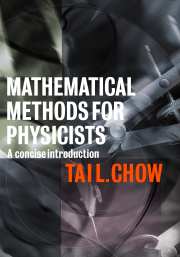Book contents
- Frontmatter
- Contents
- Preface
- 1 Vector and tensor analysis
- 2 Ordinary differential equations
- 3 Matrix algebra
- 4 Fourier series and integrals
- 5 Linear vector spaces
- 6 Functions of a complex variable
- 7 Special functions of mathematical physics
- 8 The calculus of variations
- 9 The Laplace transformation
- 10 Partial differential equations
- 11 Simple linear integral equations
- 12 Elements of group theory
- 13 Numerical methods
- 14 Introduction to probability theory
- Appendices
- Further reading
- Index
12 - Elements of group theory
Published online by Cambridge University Press: 04 August 2010
- Frontmatter
- Contents
- Preface
- 1 Vector and tensor analysis
- 2 Ordinary differential equations
- 3 Matrix algebra
- 4 Fourier series and integrals
- 5 Linear vector spaces
- 6 Functions of a complex variable
- 7 Special functions of mathematical physics
- 8 The calculus of variations
- 9 The Laplace transformation
- 10 Partial differential equations
- 11 Simple linear integral equations
- 12 Elements of group theory
- 13 Numerical methods
- 14 Introduction to probability theory
- Appendices
- Further reading
- Index
Summary
Group theory did not find a use in physics until the advent of modern quantum mechanics in 1925. In recent years group theory has been applied to many branches of physics and physical chemistry, notably to problems of molecules, atoms and atomic nuclei. Mostly recently, group theory has been being applied in the search for a pattern of ‘family’ relationships between elementary particles. Mathematicians are generally more interested in the abstract theory of groups, but the representation theory of groups of direct use in a large variety of physical problems is more useful to physicists. In this chapter, we shall give an elementary introduction to the theory of groups, which will be needed for understanding the representation theory.
Definition of a group (group axioms)
A group is a set of distinct elements for which a law of ‘combination’ is well defined. Hence, before we give ‘group’ a formal definition, we must first define what kind of ‘elements’ do we mean. Any collection of objects, quantities or operators form a set, and each individual object, quantity or operator is called an element of the set.
A group is a set of elements A, B, C,…, finite or infinite in number, with a rule for combining any two of them to form a ‘product’, subject to the following four conditions:
(1) The product of any two group elements must be a group element; that is, if A and B are members of the group, then so is the product AB.
(2) The law of composition of the group elements is associative; that is, if A, B, and C are members of the group, then (AB)C = A(BC).
[…]
Information
- Type
- Chapter
- Information
- Mathematical Methods for PhysicistsA Concise Introduction, pp. 430 - 458Publisher: Cambridge University PressPrint publication year: 2000
